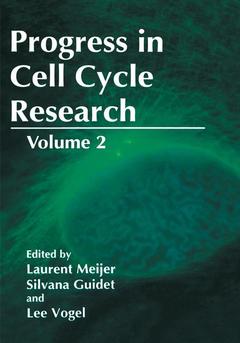Description
Progress in Cell Cycle Research, 1996
Volume 2
Progress in Cell Cycle Research Series
Coordinators: Meijer Laurent, Guidet Silvana, Vogel Lee
Language: English
Subjects for Progress in Cell Cycle Research:
Keywords
Publication date: 09-2012
284 p. · 17.8x25.4 cm · Paperback
284 p. · 17.8x25.4 cm · Paperback
Description
/li>Contents
/li>
Now in its second year, Progress in Cell Cycle Research was conceived to serve as an up to date introduction to various aspects of the cell division cycle. Although an annual review in any field of scientific investigation can never be as current as desired, especially in the cell cycle field, we hope that this volume will be helpful to students, to recent graduates considering a de1liation in subject and to investigators at the fringe of the cell cycle field wishing to bridge frontiers. An instructive approach to many subjects in biology is often to make comparisons between evolutionary distant organisms. If one is willing to accept that yeast represent a model primitive eukaryote, then it is possible to make some interesting comparisons of cell cycle control mechanisms between mammals and our little unicellular cousins. By and large unicellular organisms have no need for intracellular communication. With the exception of the mating phenomenon in S. cerevisiae and perhaps some nutritional sensing mechanisms, cellular division of yeast proceeds with complete disregard for neighbourly communication. Multicellular organisms on the other hand, depend entirely on intracellular communication to maintain structural integrity. Consequently, elaborate networks have evolved to either prevent or promote appropriate cell division in multicellular organisms. Yet, as described in chapter two the rudimentary mechanisms for fine tuning the cell division cycle in higher eukaryotes are already apparent in yeast.
A Quest for Cytoplasmic Factors that Control the Cell Cycle; Y. Masui. G1/S Regulatory Mechanisms from Yeast to Man; S.I. Reed. Regulation of G1 Progression in Fission Yeast by the rum1+ Gene Product; C. martín-Castellanos, S. Moreno. Progression Through G1 and S Phases of Adult Rat Hepatocytes; P. Loyer, et al. A temporal and Biochemical Link Between Growth Factor-Activated MAP Kinases, Cyclin D1 Induction and Cell Cycle Entry; J.N. Lavoie, et al. the Plant Cell Cycle: Conserved and Unique Features in Mitotic Control; P.C.L. John. The Function of Myc in Cell Cycle Progression and Apoptosis; P. Steiner, et al. DNA Replication Licensing Factor; J.P.J. Chong, J.J. Blow. Tyrosine Kinases Weel and Mik1 as Effectors of DNA Replication Checkpoint Control; J. Tourret, F. McKeon. Regulation of Cdc2 Activity by Phosphorylation at T14/Y15; L.D. Berry, K.L. Gould. The Family of Polo-Like Kinases; R.M. Golsteyn, et al. Sucl: cdc2 Affinity Reagent or Essential cdk Adaptor Protein?; L. Vogel, B. Baratte. Structural Basis for Chemical Inhibition of CDK2; Sung-Hou Kim, et al. Apoptosis and the Cell Cycle; R. Fotedar, et al. 9 Additional Articles. Index.
© 2024 LAVOISIER S.A.S.




